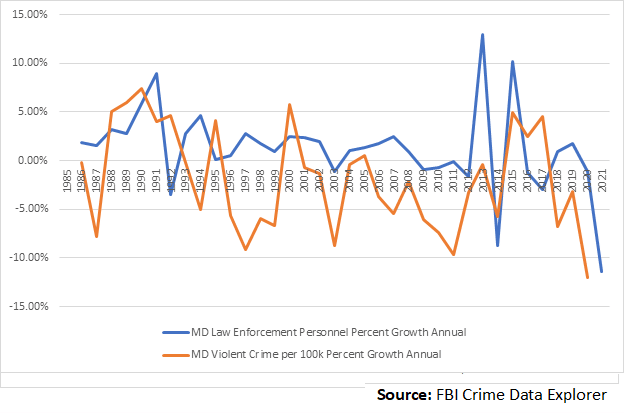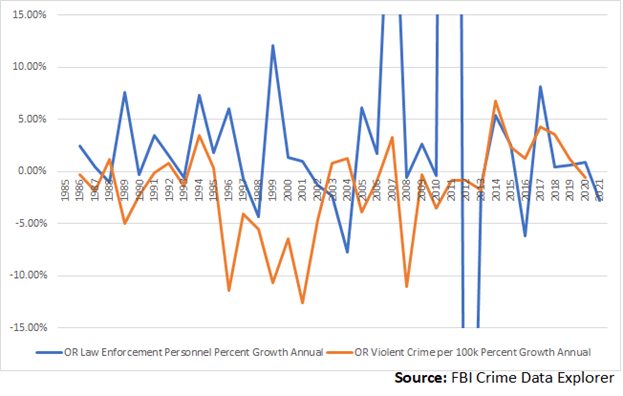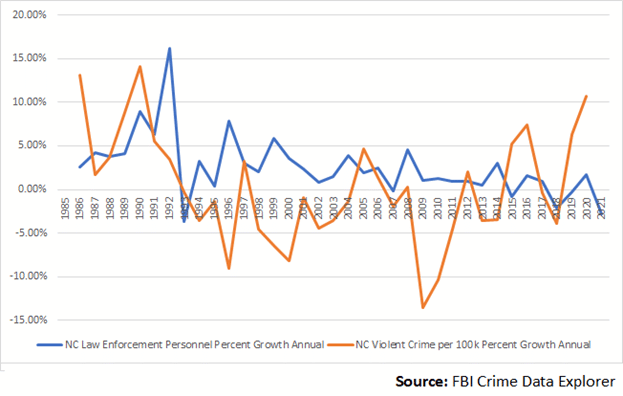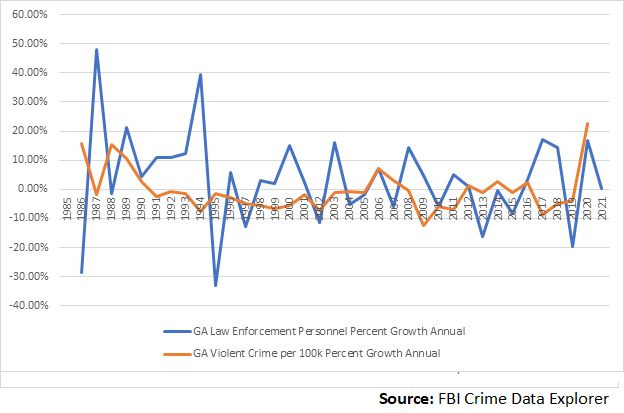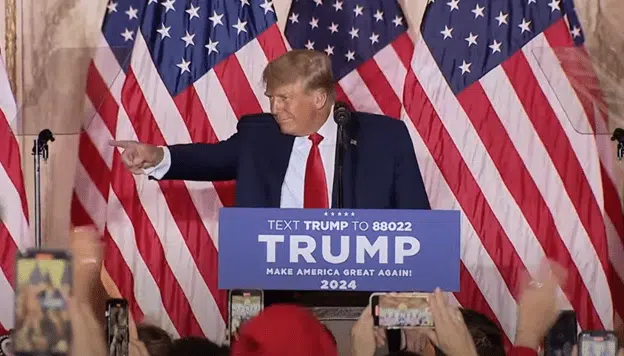Violent crime per 100,000 residents jumped by 4.65 percent as police force levels decreased 2.1 percent in 2020 during the Covid pandemic, an Americans for Limited Government study of Federal Bureau of Investigation (FBI) Crime Data Explorer data from 1985 to 2021 shows.
The pattern generally shows that to address the violent crime wave of the 1980s, surging police force levels throughout the 1990s and early 2000s were effective at reducing overall violent crime rates, as one would expect, with greater numbers of cops equaling less violent crimes reported. The mere presence of uniforms on the ground appears to serve as a deterrent.

Similar logic was applied to the Iraq War in 2007, when Gen. David Petraeus led a troop surge in a counterinsurgency against al Qaeda forces that had taken control of parts of the so-called Sunni Triangle. As the forces surged, the insurgency was quelled.
That is, until the U.S. withdrew forces under former President Barack Obama, with the last military forces leaving in 2011. Within two years, Islamic State was reclaiming the territories that the troop surge had temporarily secured, and by 2014 Abu Bakr al Baghdadi had declared a new caliphate. The U.S. commenced air strikes in 2014 but without ground forces, Islamic State was not defeated. At its height, it controlled 33 percent of Syria and 40 percent of Iraq.
Finally, in 2017, former President Donald Trump used a combination of air power and ground forces to destroy Islamic State rather quickly. By Dec. 2017, Islamic State had lost 95 percent of the territory a lack of sufficient forces and security had allowed to grow.
In a war, it is necessary to hold ground, or ground will be lost.
The lesson is power abhors a vacuum, and so why would the U.S. create a power vacuum in its own cities? And yet, that is exactly what the so-called Defund the Police movement would like to do every state, city, county and town across the country in response to numerous incidents where criminals have been killed while in police custody, including the death of George Floyd in Minneapolis, Minn. in 2020.
In Minnesota, as police forces were reduced statewide in 2020 by 2.7 percent, violent crime shot up by a whopping 16.8 percent. Similarly, as police forces were surged in the 1990s, violent crime dropped dramatically.
In Maryland, the opposite happened. When former Republican Gov. Larry Hogan came into power in 2015, he immediately surged police force levels by 10.1 percent and then kept them steady throughout his administration, with further increases in 2018 and 2019. As a result, violent crimes dropped by 6.7 percent in 2018, 3.2 percent in 2019 and 11.9 percent in 2020.
In Oregon, similar increases in law enforcement personnel throughout the 1990s led to overall drops in violent crimes reported. A drop in personnel in the early 2000s led to an uptick, followed by another surge that led to more decreases in violent crimes. In 2015, as violent crime began increasing, by 2017 police forces were increased by 8.1 percent and kept steady until finally, in 2020, violent crime dropped.
In Washington State, much the same. Surges of police forces in the 1990s and early 2000s were effective at reducing reported violent crimes. A similar uptick in violent crimes began in 2014, and eventually increasing police force levels from 2016 to 2018 led to ultimate drops in violent crimes committed in 2019 and 2020 by 3.8 percent and 3.2 percent.
In North Carolina, similar patterns emerge, where surging police forces in the 1990s led to commensurate drops in reported violent crimes, with steady increases in force levels until slowing in the 2010s. Failing to keep up with the rapid growth of North Carolina’s population, however, violent crimes have been steadily escalating. Police force levels were dropped by just 0.85 percent in 2015 leading to a jump in reported violent crimes in 5.2 percent in 2015, 7.4 percent in 2016. Further police force reductions in 2.1 percent in 2018 and 0.26 percent in 2019 led to a 6.3 percent increase in reported violent crimes in 2019 and 10.7 percent in 2020.
In Florida, yet again, similar patterns emerge, as steady increases in police force levels throughout the 1990s led to ultimate reductions in violent crimes reported in the 1990s and early 2000s. Then, decreases the later 2000s and early 2010s, including an 8.7 percent decrease in 2012, a 5.7 percent decrease in 2014 and an 8.9 percent decrease in 2015 eventually led to a 0.8 percent increase in violent crimes reported in 2015. And so Florida surged police forces again, by 13.5 percent and 12.4 percent in 2015 and 2016 under Republican Gov. Rick Scott, leading to 7.1 percent reductions in reported violent crimes in 2016, 4.9 percent in 2017, 5.4 percent in 2018 and 2 percent in 2019. However, reductions in force levels of 0.9 percent in 2018 and 1 percent in 2020 led to another 1.45 percent increase in violent crimes reported in 2020.
In Georgia, once again, increasing police force levels in the late 1980s and 1990s led to years long decreases in the number of violent crimes reported into the early 2000s. Then in 2004, 2005 and 2007, 5.3 percent, 1.7 percent and 5.9 percent decreases in police force levels led to 7.2 percent and 2.9 percent increases in 2006 and 2007, respectively. In 2013, 2014 and 2015, 16.4 percent, 0.3 percent and 8.2 percent drops in police force levels led to 2.7 percent and 2.4 percent increases in violent crimes reported in 2014 and 2016, respectively. Police force levels surged by 17.2 percent an 14.4 percent in 2017 and 2018 led to 8.7 percent, 4.5 percent and 3.7 percent decreases in violent crimes reported in 2017, 2018 and 2019. But a 19.7 percent decrease in force levels led to 22.6 percent jump in violent crimes reported in 2020.
Finally, in New York State, yet again, the same pattern emerges. Surging police forces beginning in the 1980s and 1990s eventually led to dramatic drops in violent crimes reported. Then, after Republican Mayor Rudy Giuliani left office in 2001, decreases in police force levels by 6.5 percent in 2002, 10.3 percent in 2003 and 1.6 percent in 2005 led to the eventual 0.9 percent increase in reported violent crimes in 2005, whereas a 19.2 percent surge of forces in 2004 reduced violent crime by 5.4 percent. Drops in the force levels in the 2010s led to upticks in reported violent crimes, followed by brief surges that brought the numbers down again. Most recently, 0.1 percent and 6.1 percent decreases in police force levels in 2019 and 2020 have led to 2.9 percent and 0.8 percent increases in violent crimes reported in 2019 and 2020.
It’s pretty much like clockwork. As the population increases, more well trained police are needed to keep law and order. Recently, legendary Punisher writer Mike Baron even brought attention to this problem in his hit Thin Blue Line graphic novel, it is often a thin blue line that separates our cities from law and chaos. He’s right, but unfortunately, that line keeps getting thinner each year force levels are reduced.
Ironically, as violent crimes predictably skyrocket as police force levels are reduced, that will still lead to an increase of more incidents that the overworked police have to respond to, likely leading more incidental increases in collateral damage. The individual circumstances obviously matter to whether individual policemen and women were following protocols, but the police force levels appear to have a dramatic impact on the number of reported violent crimes.
In other words, when violent crime is increasing, governors, mayors and police forces may wish to employ the logic of surging police forces, with sheer numbers acting as a deterrent. That will lead to fewer violent crimes reported, meaning ultimately fewer police responses will be needed. Whereas defunding the police and reducing force numbers will predictably lead to more violence and if allowed to persist to its extreme, ultimately, anarchy, where there won’t be any limited government to protect individual liberties and civil rights.
Robert Romano is the Vice President of Americans for Limited Government Foundation.




